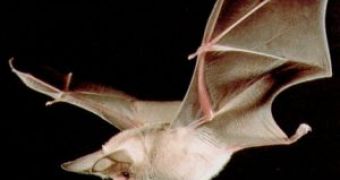Putting bat wings on the mythical vampires makes them more efficient than suspected.
Because a study using the last technology on high-resolution, three-dimensional video recordings offered for the first time details on how these amazing mammals fly, discovering unique abilities.
The research showed that bats use a totally different lift-generating mechanism than birds and insects do, and their wings are much more maneuverable, being a candidate model for tiny flying machines. "They can generate different wing shapes and motions that other creatures can't", said Kenneth Breuer, a professor of engineering at Brown University.
"The goal is not to build something that looks like a bat. We want to understand bat flight and be able to incorporate some of the features of bat flight into an engineered vehicle." said Breuer.
"The assumption has always been that bats evolved from some sort of flying squirrel-type animals," says Sharon Swartz, an associate professor in ecology and evolutionary biology at Brown University.
"Gliding has evolved in mammals seven times. That tells us that it's really easy for an animal with skin to evolve into a glider, but going from a square gliding wing to a long, skinny flapping wing has not happened seven times. It might have happened once. And now it doesn't look like bats have any relationship to these gliding things."
Bat wings are highly articulated, punctuated by more than two dozen joints.
The researchers shot videos from four angles simultaneously, which pointed how each wing movement integrated to flight speed, body position and angle of attack. They tracked joints and bones movements during the flight, marking the joints with reflective markers.
While birds and insects can fold and rotate their wings during flight, the possibilities bats have are much higher. The wing's patagium (membrane) is extended for the down stroke in straightforward flight, but as its surface is much more flexible, it curves much more than a bird's one, generating greater lift for less energy. In the up stroke, the bats are able to approach more the wings to their bodies than birds or insects, experiencing less drag.
The high flexibility of the bat wing enables them to make 180-degree turns in less than half a wingspan length.
The investigators employed a test corridor filled with a mist of non-toxic aerosol particles which tracked the airflow.
Flying bats triggered a laser imaging device, which recorded the position, speed and aerosols wake, and the collected data, even if limited by the laser setup performance, gave a new and surprising picture of the bat flight.
The vortex of the down stroke looked closely tracked to the animal's wingtip, while the vortex of the up stroke looked empowered by another location, most likely the wrist joint.
This flight pattern may be substantially saving energy model. A new laser imaging system able to capture data at 40 times the current rate will surely provide more details of this flight mechanism and aerobatic maneuvers like take off, turning and landing. "Engineers like to control things and make many, many measurements," says Swartz, the biologist. "With a living bat, we might spend days getting them to fly through our test area a few times."

 14 DAY TRIAL //
14 DAY TRIAL //